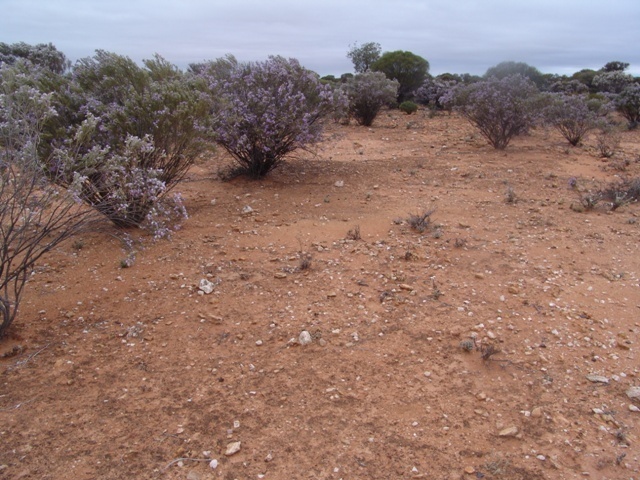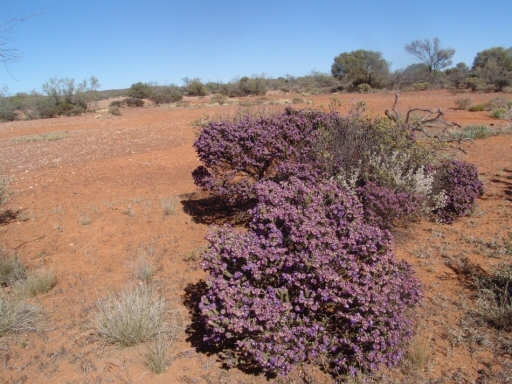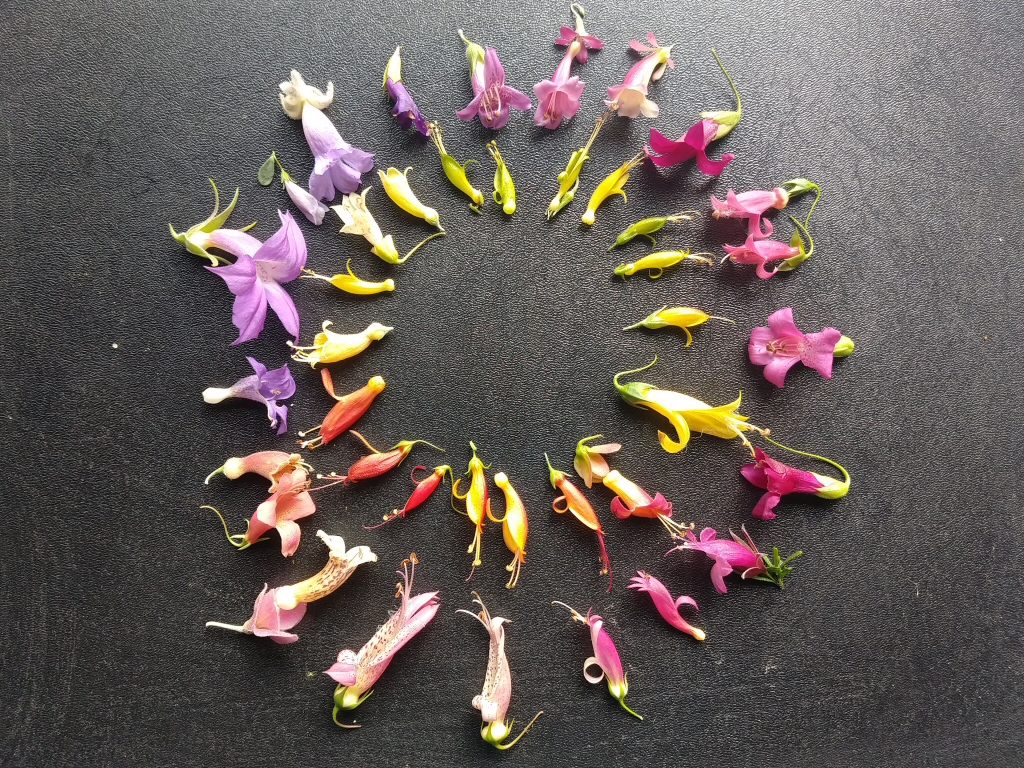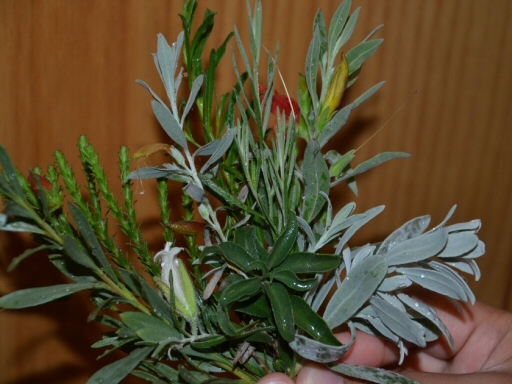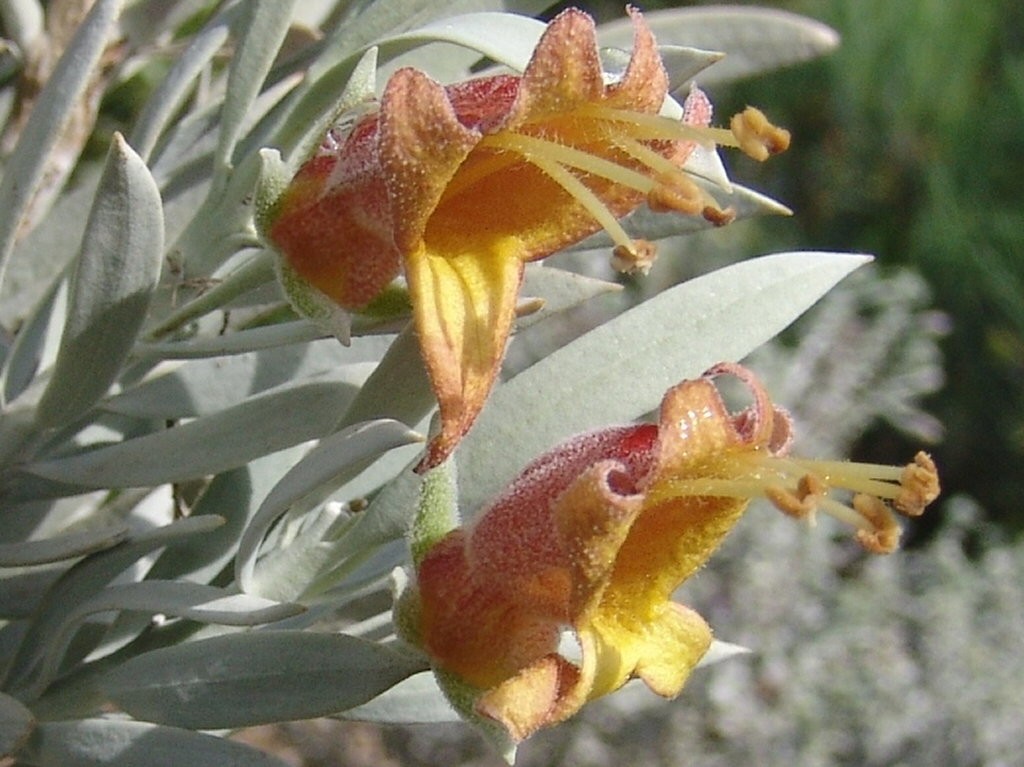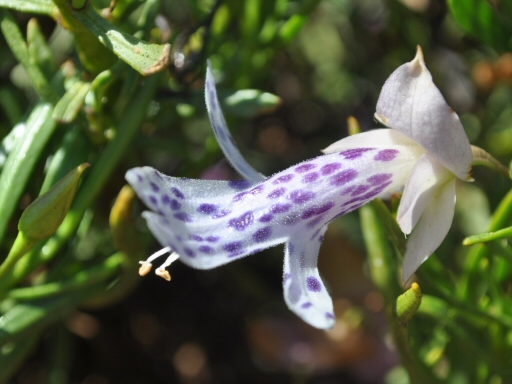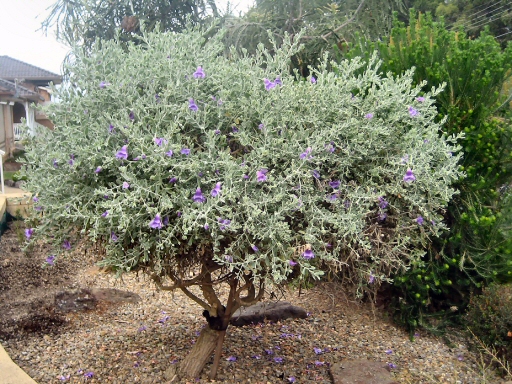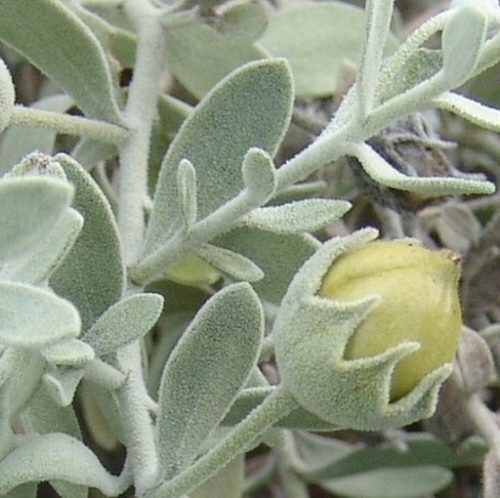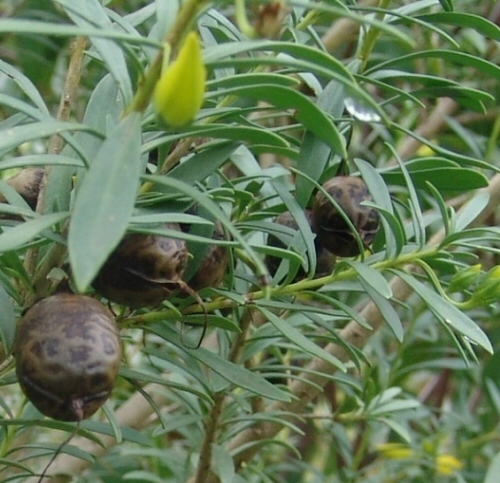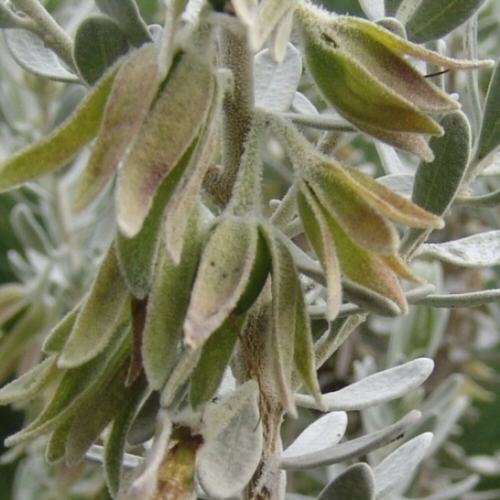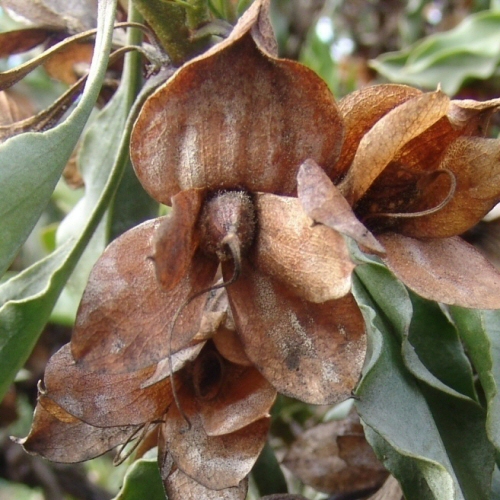Article by Dr Lyndal Thorburn
Lyndal Thorburn is leader of the Eremophila Study Group (ESG), which was founded in South Australia in 1986, under the auspices of the Australian Native Plant Society of Australia (ANPSA). Lyndal is a Life Member of the Australian Plants Society Canberra Region Inc. and a member of APS NSW. She became leader of the ESG in 2015.
Eremophilas are part of the Family Scrophulariaceae (formerly Myoporaceae) and generally grow in regions of Australia with fewer than 250mm of rain annually, and south of tropical zones. In the wild, they can be found in open areas in sparse woodlands (mulga, mallee etc) and on open plains, rocky hillsides and stony flats, as in the photo on the left (Eremophila pantonii, photo Phil Hempel). Eremophila cuneiifolia flowering in its natural habitat on the right (photo Phil Hempel).
These natural locations led those trying to grow the genus, from the mid-1960s, to assume that, as desert-lovers, they needed little water, must have sandy soil, or would not survive in frosty or seaside areas.
Luckily, many of these assumptions have proved false and, thanks to a small band of skilled people in academia and in the Eremophila Study Group (ESG), we now know the best approaches for success for many species.
Eremophilas, in short, like being treated like “normal” Australian plants in the garden – they appreciate good soil, native fertiliser, adequate water and can cope with, or even thrive under, regular pruning. They also like well-drained soils but few can tolerate very sandy soils. At the same time, they are wonderfully drought-hardy. Many home gardeners found that, in the hot dry conditions of last summer (2020), many of their Eremophilas survived with little or no supplementary water.
Over the years, the Eremophila Study Group has also, through reporting by members, also found that most Eremophila are moderately frost-hardy and many can survive frosts to minus 9 degrees Celsius.
Eremophila do well in Australian regions up to about 700mm natural rainfall per year, preferably where that rainfall is well-distributed across the year. For those in wetter climates, here are a few tips for choosing and maintaining your plants:
1. Plant specimens in breezier spots in the garden
2. Plant specimens in full sun
3. If you can afford it, buy grafted plants rather than those that are growing on their own roots – the Myoporum stock that is commonly used for grafts tolerates wet feet better. If you can’t afford grafted plants (and few species are commercially available in grafted form) then Try growing plants in raised beds or tubs to enhance drainage. Do not be tempted to plant them in sand for extreme drainage – they don’t like it!! Tubs on wheels can also be moved out of heavy downpours.
4. If you can’t provide the above three conditions, then choose species with green rather than grey leaves. Grey-leaved varieties are covered in hairs that can trap water and promote mould. While they are usually fine in sunny, breezy locations, especially if grafted, the greener leafed varieties have fewer hairs and most will resist mould better.
5. Also:
a. Prune your plants selectively – if you are growing a bushy species, then try pruning the inside of the bush so it still looks full from the outside, but has more space inside for air movement.
b. In extremely wet areas, consider a rain shelter for your most precious plants.
A small number of species e.g. (E. debile, E. glabra) grow naturally in coastal conditions (including in Queensland!). Buy them!!
If the worst happens and your plants go mouldy from excess rain then prune them back to areas of good growth. Some species of Eremophila (e.g. E. maculata, E. hygrophana, E. oppositifolia) can be pruned back to a bare trunk and they will re-shoot from there into lush shrubs. If you have one of these species, you can prune vigorously once a year (after flowering!!) – this will help reduce the impacts of too much rain.
There are over 250 species of Eremophila now described, with more identified. Flowers come in every colour – white, pink, yellow, mauve, red, green, purple – with many species showing colour morphing as flowers age. Below is a range of winter flowers from 40 different plants (photograph by Lyndal Thorburn)-
As garden subjects, Eremophilas also show great variety in foliage and form. As can be seen below, foliage ranges from grey to green and leaf shape from small and pointy to large and floppy (pic Lyndal Thorburn). Plant forms also range from absolutely prostrate to trees, although most species and forms are medium-sized shrubs.
The home gardener can plan for an Eremophila flowering in every month of the year. Below is an example of a ground cover form of Eremophila glabra growing in Victoria (pic Bernie Shanahan)
Eremophila macgiillivrayi, which grows to 3m high, shows how well flowers can also be attractively displayed against the foliage (photo Phil Hempel). In Eremophila, grey foliage is covered in fine hairs.
There are also “tall skinny” forms, as shown with E. calorhabdos, below, a bird attractor (pic Russell Wait (left) and Phil Hempel (right)).
Some species, such as E. abietina subsp. ciliata (pictured below) have spectacular bracts which stay on the plant after the flower dies, providing colour for many months (pic Brian Freeman).
While many species can be propagated from cuttings, grafted forms will survive in gardens longer in the wetter climates of Sydney and Melbourne. Below is a photo of the grey-leaved form of E. macdonnelli grafted onto a Myoporum stock, growing in a garden in Sydney (pic Karlo Taliana).
Many species also have interesting fruits. Below, fruits of Eremophila glandulifera, E. macdonnellii, E. maculata (top) and E. bowmanii, E. fraseri, E. georgei (bottom) (photos Phil Hempel). There is an Eremophila suitable for every garden!
The Eremophila Study Group is supporting development of new varieties for the home gardener. These are being released through commercial wholesalers as well as Australian Native Plant Society public plant sales. The Study Group is pleased to recognise support of Native Plant Wholesalers, which makes a donation to us on the sale of those cultivars registered by the Study Group. Cultivars are chosen for their larger and more spectacular flowers. For example, ‘Mallee Lipstick’ was released in 2019 – it is a hybrid between E. maculata subsp. brevifolia and E. glabra and has a spectacular pink flower during autumn and winter. It is a vigorous ground cover with a grey-green leaf (photo below Lyndal Thorburn).
Eremophila ‘Meringur Isaac’, released in 2020, is a hybrid between E. bignoniiflora and E. polyclada. (Another hybrid of these two species, sold as Big Poly, is cream). Meringur Isaac is a large shrub growing to 5m x 3m and has a spectacular purple flower in summer. Photo of it below is by Brian Freeman.
As a highly diverse genus, Eremophila is well worth a look in your garden.
WHERE TO BUY EREMOPHILA
http://www.anpsa.org.au/eremophilaSG/BuyingEremophilaMarch2020.pdf
WHERE TO BUY BOOKS ON EREMOPHILA
There are two books currently in print on Eremophila.
Andrew Brown and Bevan Buirchell published the second edition of their “Field Guide to the Eremophilas of Western Australia” in 2021. This update of the 2011 first edition describes the species, subspecies and varieties currently found in the wild in Western Australia and also provides a detailed, easy to digest introduction to the genus, making it an essential purchase for lovers of Eremophila. Structured the same as the first edition, the revised edition adds an amazing 22 named taxa and 16 unnamed taxa, a reflection of the enduring passion of authors Andrew Brown and Bevan Buirchell in their exploration of the WA bush. Andrew and Bevan are currently Research Associates at the WA Herbarium where they continue their taxonomic work on Eremophila. This taxonomic work, combined with extensive ongoing field work, has resulted in the formal descriptions of many new Eremophila species since the first edition. The guide devotes one page to each species or subspecies and includes detailed photos and maps for each. Inquiries and orders can be placed with Andrew Brown at watscu01@gmail.com.
Russell Wait, long time member of the Eremophila Study Group, also published his book “Growing Eremophila” in 2021. This is a beautiful, glossy production worthy of a prominent place on any coffee table, not just the reference library. At 500 pages it a gardening handbook and an invaluable compendium that is clearly presented and comprehensive in its scope. It covers not only every species and subspecies in Australia, but also every hybrid and cultivar, and even different forms (many as yet undescribed). While the book is a personal offering from Russell, a renowned Eremophila expert, collaborators from academia and the plant world contribute articles, editing and layout. Co-authors Christine Huf, Cathy Powers and Dr Jenny West deserve special credit for the excellent presentation of this book which, although large, is easy to read and navigate. The project has been supported by Dr R. J. (Bob) Chinnock, the botanical authority behind modern advances in Eremophila knowledge. Russell draws on decades of personal experience in the wild as well as in the garden, and a 30,000-strong photographic archive form which the photos in the book have been chosen. There are three photos for each entry – a large close-up of the flower, a view of the foliage with flowers, and one of a plant – plus a concise description, brief propagation and cultivation notes, a distribution map, and succinct author’s note. For inquiries and orders email Russell at eremophilabook@gmail.com.
WANT TO JOIN THE EREMOPHILA STUDY GROUP?
http://www.anpsa.org.au/eremophilaSG/index.html
LEARN MORE IN THE EREMOPHILA STUDY GROUP NEWSLETTER ARCHIVES
http://www.anpsa.org.au/eremophilaSG/ESG-news.html
BROWSE THE EREMOPHILA STUDY GROUP’S IMAGE DATABASE
http://www.anpsa.org.au/eremophilaSG/gallery/index.html


